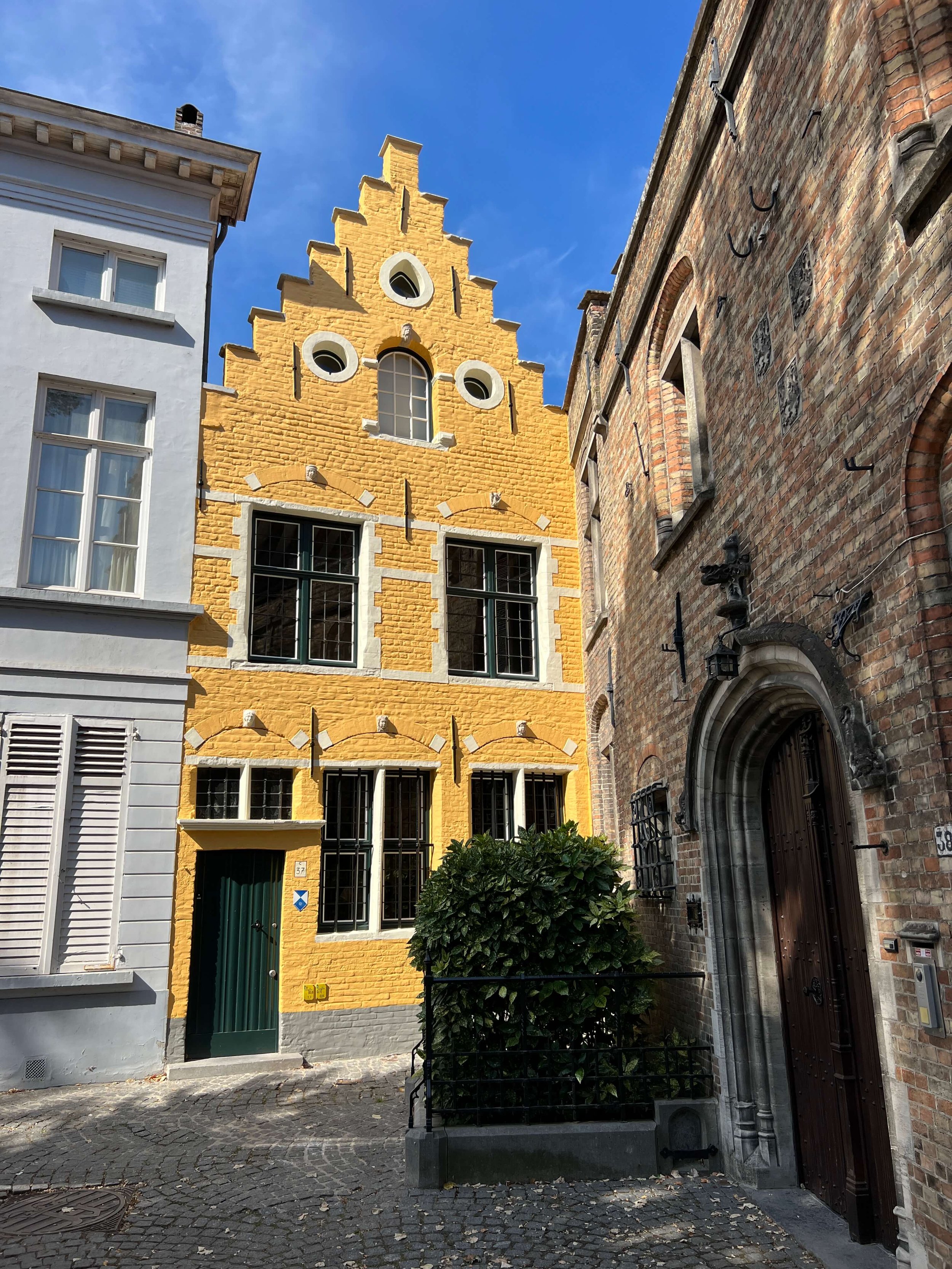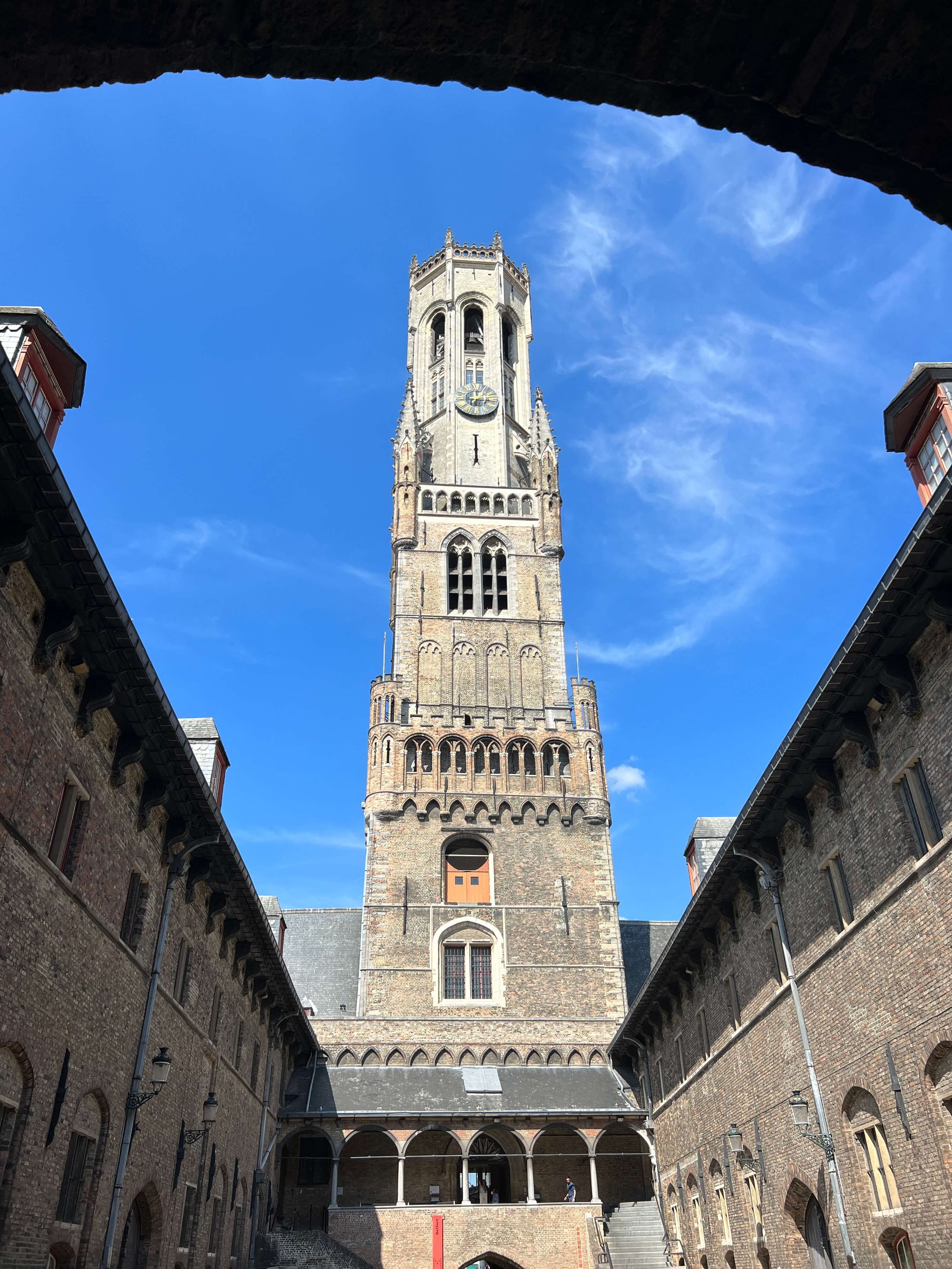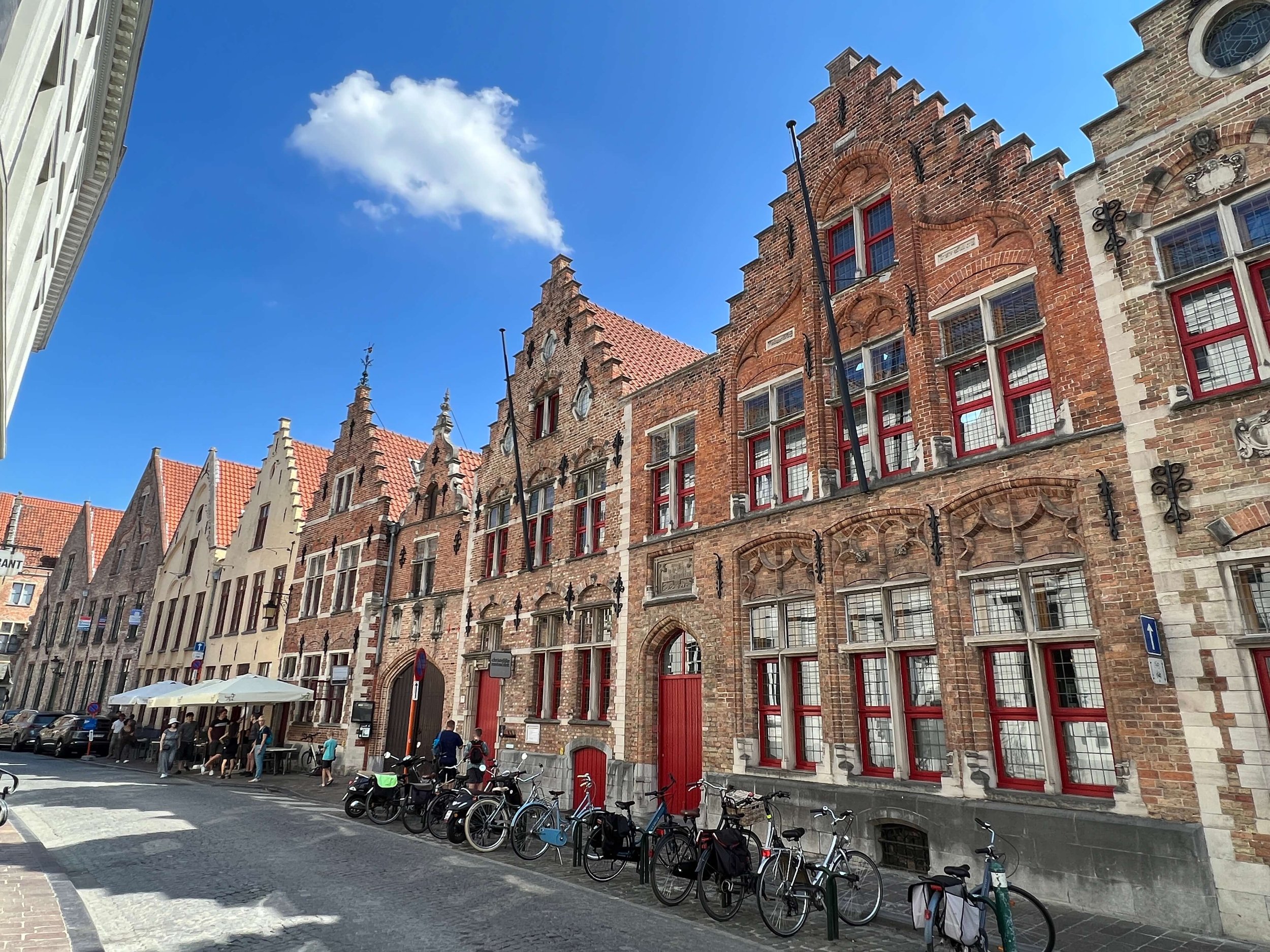Bruges Day Trip
Whew…it’s been quite the day. I woke up at 0300am before my 0330 alarm. My car came at 0430. My flight 2 hour from Budapest to Brussels was on time and I arrived in Brussels Airport Zaventem about 0830. A car was waiting for me to take me to Ghent, and I arrived at my hotel about 0930, too early to check in. I dropped my bag in a closet near the front desk and after discussing with the receptionist at the hotel who said the weekend in Bruges would be even more crowded with tourists than today, I decided to head straight to Bruges. Of course, crowded is relative. Bruges is a mecca of tourism & crowds.
I grabbed a tram near the hotel to the Gent-Sint-Pieters railway station, bought a ticket to Bruges on the spot, and jumped on the train. It takes about 30 minutes to get there. I walked out of the train station and followed the crowd of people all heading in the same direction, towards town. The town is small and very easy to walk everywhere. I had a few things on my list to check out…so here I am, finally checking out this place I’ve heard of for a very long time and had on my list as a “must see”.
Here’s a bit of geography & language insight into Belgium just for reference if you are traveling through the country, or just looking things up online. Belgium has three major regions and 3 official languages. Flanders to the north comprises about 60 percent of the population and the language this community speaks is called “Belgian-Dutch” and/or “Flemish.” The 2nd region is Wallonia in the south and then there is Brussels, the third region, both make up most of the remainder of the 40% of the population. Wallonia and Brussels officially speak French. To make things a bit more complicated, there is the tiny German-speaking community, the 3rd official language of Belgium, found in the eastern regions on the border with Germany. They form roughly 1 percent of the population of Belgium and were only incorporated into the country after World War I.
Now for the name of the town because you will see it spelled in a couple of ways, both are correct. It’s Bruges in French as well as English, and it’s Brugge in Flemish (or Dutch). I will use the English version throughout just to be consistent.
Outside of Brussels, the most well-known and most visited city in this country is Bruges located in Dutch speaking Flanders. When people talk and write about Bruges, it’s revered as a medieval, fairytale city and seems to be on every tourists bucket list imaginable. It’s considered Belgium’s most perfectly preserved medieval town and the historic city center is a prominent World Heritage Site of UNESCO. Along with a few other canal-based northern cities, such as Amsterdam, it is sometimes referred to as the “Venice of the North.” Admittedly, It does seem that every city with a canal system gets a “Venice” reference. There are more than 80 bridges used to cross the canals in Bruges so you are continuously rewarded with lovely views of this canal city.
Some interesting history, in the last half of the 19th century, Bruges became one of the world’s first tourist destinations attracting wealthy British and French tourists. In World War I German forces occupied Bruges but the city suffered virtually no damage and was liberated on 19 October 1918 by the allies. From 1940 in World War II the city again was occupied by the Germans and again spared destruction. On 12 September 1944 it was liberated by Canadian troops.
Bruges’ image as one of the last untouched medieval towns with picturesque architecture and a wealth of canals, is obviously important to its identity – especially in the tourism industry. That was the impression I got right from the moment I arrived, that the town caters to tourists. Therefore, you will see plenty of horse pulling cart rides clippity clopping through the cobbled streets that are overflowing with humanity looking to buy all that this place (and Belgium) is known for…chocolates, waffles, lace and beer.
I fell in love with the architecture of the centuries-old stair-step gabled buildings in all the different colors lining a web of canals and cobblestone streets, the vibe is quintessentially Old-World Europe.
I proceeded to walk 7+ miles exploring town, took 100s of pictures, bought some very special Belgian chocolate at a well-known family-owned place, went to the Salvador Dali Museum in Markt (which was cool, see next post), and enjoyed a local house beer in what they say is “probably the oldest pub in the world,” opened in 1515.
First up on the itinerary…Markt, which was founded as a market square in 958. Apparently this is the perfect place to demonstrate what the old saying, “all roads lead here,” means because in Bruges they literally do. The building numbers start at 1 at the edge of the square and move out. Therefore, if you need to get back to the square just follow the descending numbers on any street. If that street reaches another street, follow the descending numbers on that street and eventually you will end up back in the Markt.
In the center is a statue of Jan Breydel and Pieter de Coninc, celebrated heroes of the Golden Spur battle in 1302, when French Belgium was forced to recognize Flemish emancipation. Also, in the square built in 1220, the Bruges Belfry – also known as Belfort, more was added in 1240 and then there was the reconstruction after it burned down in 1280, again in 1491, and again in 1781. This feels like a lot of fires for just one tower. It stands 83 meters/272 feet high and is a 366-step climb up to gain a view of the entire city.
Also in the square is The Basilica of the Holy Blood, so-called because it houses a relic which allegedly has the actual Blood of Christ on it, brought back from a Jerusalem crusade in the 12th century. The church is a Romanesque and Gothic creation that was constructed in the 12th-century.
Forget those marbled seashells – real Belgian chocolate is finely ground, with a high cocoa content and pure cocoa butter. The Chocolate Line (Simon Stevinplein) is a family-run chocolate factory in the city center, where choc aficionados Fabienne and Dominique – along with their son Julius – make delicious artisanal products while supporting sustainability and social projects. Visit to see (and taste) how their chocolate is made, plus how they give back. I have to say, I think this is the best chocolate with caramel (my favorite) center I have ever had.
I decided the perfect place for a cold Belgian beer would be Café Vlissinghe. I can write the name, please don’t ask me to pronounce it! Founded in 1515, Vlissinghe is the oldest tavern in Bruges and as their sign says, “probably the oldest pub in the world.” It’s charming inside and out, there is a nice garden to sit in out back. This pub didn’t adopt modern beer taps and towers until the 1960s. Prior to that, the pub owner had to go to the cellar to tap each beer from the barrels stored there.
Legend has it that the first owners of Café Vlissinghe, “Old Teunis and his wife,” lived to be a hundred years old and died on the same day. Their portrait still hangs on the wall to the far upper-right of the fireplace. An oil-on-wood painting in the arch above the entry to the dining room bears witness to the region’s maritime history while offering hints about the original proprietors origens, Vlissingen in the Netherlands.
The Rozenhoedkaai – named after the rosaries that were once sold here – is vintage Bruges. Its painterly composition of reflective canals, ancient houses, a quaint bridge and the Belfry peeking out from the back, make it the most photographed spot in the city.
Béguinage de Bruges (Address: Ten Wijngaerde)
There is a lovely quiet area just near the city center that is well worth visiting or just taking a stroll through to find a peaceful respite from the crowded streets. The beguinage of Bruges was founded in 1245 and was placed under direct royal authority in 1299 and was subsequently awarded the title of “Princely Beguinage.” You enter the Beguinage over a small bridge and through a gatehouse dating from 1776.
Given I had never heard of a “beguinage” I did some research. A beguinage is an architectural complex which was created to house beguines. Beguines are lay religious women in the cities of northern Europe who, beginning in the Middle Ages, lived in community without interest in taking vows to become a nun nor a wife, nor did they want to retire from the world. Most supported themselves, often by nursing or cloths & lacemaking, and they spent time in religious contemplation. Beguines promised to preserve chastity while they remained in the community, but they were free to leave it and marry any time they choose.
Some beguinal communities cultivated intense forms of mysticism. This is to be expected given you have a community of independent woman relying completely on themselves. AND, coming as no surprise this led many people to suspect them of heretical tendencies. Throughout the 13th century they were the object of prejudice and of restrictive legislation, and in 1311, at the Council of Vienne, decrees were drawn up that ordered the dissolution of beguinal communities. Thereafter official policy varied until the 15th century when a consistent policy of toleration was established.
One of the most remarkable Beguines was Marguerite Porete, who was burned for heresy in Paris in 1310. Her mystical work Miroir des simples âmes (c. 1300; The Mirror of Simple Souls) is an early 14th-century work of Christian mysticism and thought to be the greatest religious tract written in Old French at a time when Latin was the prescribed language for religious literature. It explores in poetry and prose the seven stages of 'annihilation' the Soul goes through on its path to Oneness with God through love.
The male counterparts of Beguines were known as Beghards. They never achieved the same prominence, and the few communities that survived in Belgium were suppressed during the French Revolution.
The number of beguines increased considerably in the course of the 15th and 16th centuries. The Bruges Beguinage witnessed a major boom in the 17th and 18th centuries, which resulted in intensive building activity. The boom was definitively over after the French Revolution and the beguinage gradually fell empty. The last beguinage member of Bruges left in 1927 and since then it has been home to a community of Benedictine nuns.
Out of respect, it is requested that you maintain silence as you walk through the grounds. I'm told, if you visit in the spring the entire green lawn is covered with daffodils.
Then I walked to see the Windmills on the canals. Sint-Janshuismolen (St. John’s House Mill) and Koeleweimolen (Koelewei Mill) are just 2 of the 4 windmills along the park and river that encircles the city. Both structures are about a 15-minute walk from any point in central Bruges. Sint-Janshuismill windmill was built in 1770, the oldest windmill in Bruges, still grinds flour to this day.














































































